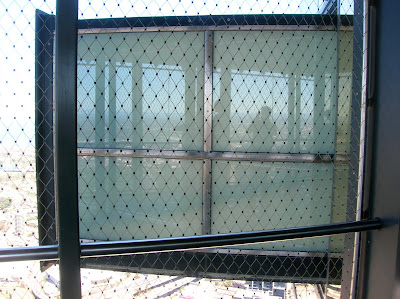I just got back to Sydney from my week of traveling, so I'm going to do the same thing as last time... one day at a time.
The first stop was Melbourne, which was an amazing city. The weather was great (unlike the rainy Sydney that I had just left).

St. Paul's Cathedral, across the street
I ended up going into the Ian Potter Centre, an art gallery in Federation Square with both Aboriginal and European Australian Art. A lot of the Aboriginal art was of a similar style to what I had seen in Alice Springs, but there were also some more contemporary works, most of which were political, dealing with issues like the Stolen Generations and Aboriginal land rights. There was one piece that was a series of small portraits of the family members of the artist, reaching back over generations, who had been affected by Australian policies - in the background of each portrait would be some representation of the Aboriginal/European relations at the time.
In the European section of the gallery there were many paintings from all over Australia - some showed the landscapes of Sydney and Melbourne before there were cities there; there was one, impressionistic and in bright colors, that showed the Sydney Harbour Bridge when it was still under construction.
After the art museum, I went to get some lunch, and ended up in a maze-like warren of small alleys packed with cafes and sandwich shops, all full of people. I grabbed a very good (and very cheap) sandwich and began walking towards my next destination, the Eureka Tower:

The Eureka Tower, the tallest residential building in the world and home to the highest observation deck in the southern hemisphere, 300 meters above the city. The view from the top was spectacular:
While I was up there also had the opportunity to do "The Edge Experience" - you get into a glass room, the door closes behind you, and the entire room extends 3 meters out the side of the building (the glass is opaque at the time, and the staff play some lovely elevator music for you - The Girl from Ipanema). Once you are out, the glass suddenly turns transparent (accompanied by the sound of breaking glass over the speakers...), and you're looking straight down, 300 meters, to the street below. It is an amazing view. You aren't allowed to take cameras inside, but you can see the Edge from the platform:

First you can't see...

... then you can.

After the Eureka Tower, I went back to wander around the city, and eventually found this:

ACDC Lane - named after the great Australian rock band, AC/DC
After that I walked over to the Queen Victoria Gardens and the King's Domain, the green area I could see from the tower. Eventually I came to the Shrine of Remembrance, which was built as a memorial to Victorian soldiers in WWI. The design is based on that of the Temple of Halicarnassus, one of the Seven Wonders of the Ancient World. Inside, there is a small museum, a crypt which houses all the regimental colors which have been retired and a statue of "Father and Son," representing the two generations that were devastated by the World Wars. Above the crypt is the sanctuary, a small square room with a stone recessed into the ground in the center. On the stone is carved the words "Man hath no greater love than this." There is a small aperture in the ceiling, and apparently every year on the 11th of November, at 11:00 am, the sun shines through that aperture and the beam traverses the stone, going right across the word "love." Each year there is a Remembrance Day service at the Shrine, which centers around this event.
In the courtyard outside is the WWII Memorial, with an eternal flame that has been burning since it was lit by Queen Elizabeth II in 1954. The outer walls of the Shrine have inscriptions on them to commemorate other conflicts since the Shrine was built. Next to the Shrine are two pine trees - one young, one old. They are the "Lone Pine Trees," planted from the seeds of the Lone Pine which gave the Battle of Lone Pine in Gallipoli its name; Australian soldiers brought home pine cones from that tree after the battle.

The Shrine, with the Lone Pines visible to the left

Melbourne from the Shrine steps

After that I walked back to the city and headed to the Queen Victoria Markets for dinner. There is a night market on Wednesdays, with all kinds of food and live bands - every other weekday there is a huge open-air market during the day. One of the bands, a trio (guitar, violin, and cello) was playing Scottish folk music, then suddenly caught my attention when they started playing Townes Van Zandt - "If I Needed You." It was an interesting arrangement, lots of vocal harmony, and very well done.
After that I headed back to the hostel to get some sleep before my tour of the Great Ocean Road the next day.





















































